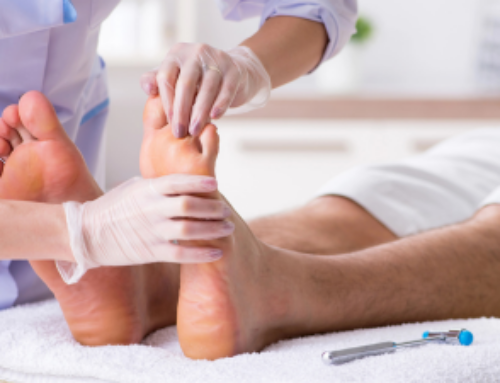Whether you’re dealing with foot pain, want to improve your circulation, or are seeking better performance during physical activities, compression socks may be the answer. While podiatrists and medical professionals recommend compression socks for various foot problems, it’s important to understand the benefits of compression socks and learn how to choose the right pair to keep your feet healthier, happier, and performing at their best.
What are compression socks?
Compression socks are specialized garments that apply pressure to the lower legs, ankles, and feet. They work by gently squeezing the legs and feet to help enhance blood circulation, particularly in the veins, promoting better flow back to the heart.
These socks are crafted from elastic materials that apply various levels of pressure. They are often tighter at the foot and ankles and gradually decrease the pressure toward the calves. By providing this gentle pressure, compression socks help reduce swelling, ease foot and ankle discomfort, and minimize the risk of blood clots.
Compression socks are available in various sizes, lengths, and compression levels.
Compression socks help alleviate foot pain
The enhanced circulation provided by these socks can minimize inflammation, soothe soreness, and increase oxygen flow in the legs and feet, which can promote faster recovery from foot and ankle injuries. Additionally, the compression applied by these specialized socks support the arches of the feet and provide stability to the ankles, which can alleviate strain on both the foot’s ligaments and muscles.
Podiatrists recommend compression socks to help alleviate paid caused by a wide range of foot ailments:
- Plantar fasciitis: Compression socks provide arch support, reduce inflammation, and minimize strain on the plantar fascia ligament, offering relief from the pain associated with plantar fasciitis.
- Foot and ankle swelling and edema: They help reduce foot and ankle swelling and edema by improving blood circulation and aiding in the movement of fluid from the lower extremities back toward the heart.
- Venous insufficiency: Compression socks can assist in managing the symptoms of venous insufficiency and varicose veins by promoting better circulation and reducing discomfort.
- Achilles tendonitis: By providing support and reducing strain on the Achilles tendon, compression socks can help alleviate pain and discomfort associated with achilles tendonitis.
- Muscle fatigue and soreness: Compression socks can reduce muscle extension during physical activities, decreasing muscle fatigue and soreness in the feet and ankles after you exercise. This can be especially helpful for anyone who has experienced past foot or ankle injuries.
- DVT (Deep Vein Thrombosis): For individuals at risk of DVT, compression socks can help prevent blood clot formation by promoting healthy blood flow, especially during prolonged periods of inactivity like travel or recovery from surgery.
- General foot discomfort: They can alleviate general foot discomfort —including aches, pains, and fatigue—and provide increased comfort during daily activities or prolonged standing.
How to select the right pair of compression socks
There are multiple kinds of compression socks, from graduated compression socks that provide targeted relief for swelling and circulation to specialized varieties, including athletic, medical-grade, and travel compression socks. Each type serves a unique purpose.
When selecting compression socks best suited for your foot and ankle, consult a podiatrist or medical professional who can help you consider a number of factors:
Compression level
Consider the compression level recommended for your condition. Compression socks are measured in millimeters of mercury (mmHg). Mild compression (8–15 mmHg) is suitable for daily wear and mild symptoms, while higher levels (15–20 mmHg, 20–30 mmHg, and 30–40 mmHg) are for more severe conditions. Only a medical provider should prescribe higher level medical-grade socks.
Size and fit
Proper sizing is crucial for the effectiveness of the socks. To ensure a proper fit, measure your ankle circumference, calf circumference, and leg length while following the manufacturer’s sizing guide for accuracy.
Material and comfort
Look for socks made from breathable, moisture-wicking materials to ensure comfort, especially if you plan to wear them for extended periods of time. Consider preferences for materials like nylon, spandex, or other moisture-wicking fabrics. Be sure to wash your compression socks regularly, to avoid other secondary conditions, such as athletes’ foot.
Consult a professional
For specific foot and ankle conditions or if you are uncertain about the right compression level you need, consult a healthcare professional to get personalized guidance. Using medical-grade compression socks incorrectly can harm your legs, ankles, and feet.
If you’re interested in learning more about how compression socks may help relieve your foot pain or enhance your athletic performance, schedule an appointment at one of our five Tulsa metro locations. And remember, prevention is always better than treatment, so take steps to protect your feet and ankles and prevent injuries.
The information, text, graphics, images, and other material contained on this website are for informational purposes only. No material on this site is intended to be a substitute for professional medical advice, diagnosis, or treatment. Always seek the advice of your physician or other qualified health care provider with any questions you have regarding a medical condition or treatment and before undertaking a new health care regimen, and never disregard professional medical advice or delay in seeking it because of something you read on this website.
Subscribe to stay up-to-date on news and tips from us.





